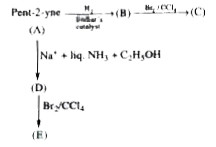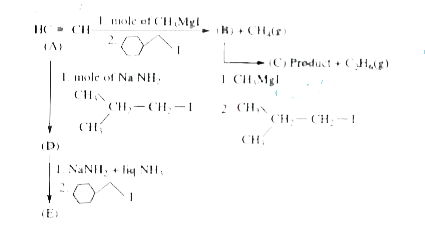Hydroboration is a reaction in which the boron hydride acts as an electrophile, R2BH adds to a carbon - carbon double which acts as a nucleophile

Organoborane compound The organoborane compound then is oxidised by treatment with hydrogen peroxide in aqueous sodium hydroxide to from alcohol. The OH group enters the carbon atom from the same side where the boron atom was present. Hence this reaction is highly regioselective and the boron atom attacheto that carbon atom which is less sterically hindred.
 Solution in Telugu
Solution in Telugu




The correct Answer is:C
Hydroboration oxidation method follows, Antimerkovnikov product (alcohol), syn addition, no, rearrangement, both attaches the less hindered double bonded carbon so the product is .c.
Topper's Solved these Questions
- HYDROCARBONSBOOK - AAKASH SERIESCHAPTER - HYDROCARBONSEXERCISE - ADDITIONAL PRACTICE SHEET ( LEVEL-II (LECTURE SHEET (ADVANCED) (LINKED COMPREHENSION TYPE QUESTIONS(PASSAGE-III))))
3 Videos
- HYDROCARBONSBOOK - AAKASH SERIESCHAPTER - HYDROCARBONSEXERCISE - ADDITIONAL PRACTICE SHEET ( LEVEL-II (LECTURE SHEET (ADVANCED) (LINKED COMPREHENSION TYPE QUESTIONS(PASSAGE-IV))))
3 Videos
- HYDROCARBONSBOOK - AAKASH SERIESCHAPTER - HYDROCARBONSEXERCISE - ADDITIONAL PRACTICE SHEET ( LEVEL-II (LECTURE SHEET (ADVANCED) (LINKED COMPREHENSION TYPE QUESTIONS(PASSAGE-I))))
3 Videos
- GENERAL ORGANIC CHEMISTRYBOOK - AAKASH SERIESCHAPTER - GENERAL ORGANIC CHEMISTRYEXERCISE - QUESTIONS FOR DESCRIPTIVE ANSWERS
35 Videos
- HYDROGEN AND ITS COMPOUNDSBOOK - AAKASH SERIESCHAPTER - HYDROGEN AND ITS COMPOUNDSEXERCISE - QUESTIONS FOR DESCRIPTIVE ANSWERS
20 Videos
Similar Questions

Compounds (B) and (D) are, respectively
View Solution
Product (B) is
View SolutionAddition of HX on alkene proceed through formation of carbocation . This reaction is follows Markovnikov's rule. According to markovnikov's rule addition of electrophile occurs on that carbon of alkene which have more number of -H atom
Ph−CH=CH2−−→HXPh−x∣CH−CH3(major)+Ph−CH2−CH2−X(minor)
Which of the following alkenes can produce diastereomers
View SolutionMention the hybridisation stste of each carbon in the following compounds.
CH3−CH=C=O,CH3−C≡C−CH3,CH3COCH3andCH2=CHCN
View SolutionWhy the use of hard water is disadvantages?
View SolutionIn reaction of hydrogen peroxide and sodium carbonate, H2O2 acts as____.
View SolutionThe presence of −OH groups on adjacent carbon atoms can be detected by the reaction of the compound.
View SolutionBorane is an electron deficient compound. It has only six valence eletons, so the boron atom lacks an octet. Acquiring an octet is the driving force for the unusual bonding structure found in boron compounds. As an electron deficient compound, BH_(3) is a strong electrophile, capable of adding to a double bond. This hydroboration of double bond is though to oC Cur in one step, with the boron atom adding to the less highly substituted end of the double bond. In transition state, the boron atom withdraws electrons from the pi bond and the carbon at theother end of the double bond acquires a partial positive charge. This positive charge is more stable on the more highly subsituted carbon atom. The second step is the oxidation of boron atom, removing it from carbon and replacing it with hydroxyl group by using H_(2)O_(2)//OH^(bar(..)) . The simultaneous addition of boron and hydrogen to the double bond leads to a syn addition. Oxidation of the trialkyl borane replaces boron with a hydroxyl group in the same stereochemical position. Thus, hydroboration of alkenen is an example of steropecific reaction, in which different steroisomers of starting compounds react to give different steroisomers of the product. Find the product of following reaction
View SolutionBorane is an electron deficient compound. It has only six valence eletons, so the boron atom lacks an octet. Acquiring an octet is the driving force for the unusual bonding structure found in boron compounds. As an electron deficient compound, BH_(3) is a strong electrophile, capable of adding to a double bond. This hydroboration of double bond is though to oC Cur in one step, with the boron atom adding to the less highly substituted end of the double bond. In transition state, the boron atom withdraws electrons from the pi bond and the carbon at theother end of the double bond acquires a partial positive charge. This positive charge is more stable on the more highly subsituted carbon atom. The second step is the oxidation of boron atom, removing it from carbon and replacing it with hydroxyl group by using H_(2)O_(2)//OH^(bar(..)) . The simultaneous addition of boron and hydrogen to the double bond leads to a syn addition. Oxidation of the trialkyl borane replaces boron with a hydroxyl group in the same stereochemical position. Thus, hydroboration of alkenen is an example of steropecific reaction, in which different steroisomers of starting compounds react to give different steroisomers of the product. Y is :
View SolutionBorane is an electron deficient compound. It has only six valence eletons, so the boron atom lacks an octet. Acquiring an octet is the driving force for the unusual bonding structure found in boron compounds. As an electron deficient compound, BH_(3) is a strong electrophile, capable of adding to a double bond. This hydroboration of double bond is though to oC Cur in one step, with the boron atom adding to the less highly substituted end of the double bond. In transition state, the boron atom withdraws electrons from the pi bond and the carbon at theother end of the double bond acquires a partial positive charge. This positive charge is more stable on the more highly subsituted carbon atom. The second step is the oxidation of boron atom, removing it from carbon and replacing it with hydroxyl group by using H_(2)O_(2)//OH^(bar(..)) . The simultaneous addition of boron and hydrogen to the double bond leads to a syn addition. Oxidation of the trialkyl borane replaces boron with a hydroxyl group in the same stereochemical position. Thus, hydroboration of alkenen is an example of steropecific reaction, in which different steroisomers of starting compounds react to give different steroisomers of the product. CH_(3)-underset(CH_(3))underset(|)overset(CH_(3))overset(|)C-CH=CH_(2) underset((ii)H_(2)O_(2)//OH^(bar(..)))overset((i)BH_(3)//THF)rarrZ . Z is :
View SolutionBorane is an electron deficient compound. It has only six valence eletons, so the boron atom lacks an octet. Acquiring an octet is the driving force for the unusual bonding structure found in boron compounds. As an electron deficient compound, BH_(3) is a strong electrophile, capable of adding to a double bond. This hydroboration of double bond is though to oC Cur in one step, with the boron atom adding to the less highly substituted end of the double bond. In transition state, the boron atom withdraws electrons from the pi bond and the carbon at theother end of the double bond acquires a partial positive charge. This positive charge is more stable on the more highly subsituted carbon atom. The second step is the oxidation of boron atom, removing it from carbon and replacing it with hydroxyl group by using H_(2)O_(2)//OH^(bar(..)) . The simultaneous addition of boron and hydrogen to the double bond leads to a syn addition. Oxidation of the trialkyl borane replaces boron with a hydroxyl group in the same stereochemical position. Thus, hydroboration of alkenen is an example of steropecific reaction, in which different steroisomers of starting compounds react to give different steroisomers of the product. underset((ii)H_(2)O_(2)//OH^(bar(..)))overset((i)BH_(3)//THF)rarr "product" . The product is
View SolutionIn the reaction between boron and sodium hydroxide to liberate hydrogen gas, boron acts as
View SolutionIn the reaction between boron and sodium hydroxide to liberate hydrogen gas, boron acts as
View SolutionHydroboration is a reaction in which the boron hydride acts as an electrophile, R_2BH adds to a carbon - carbon double which acts as a nucleophile Organoborane compound The organoborane compound then is oxidised by treatment with hydrogen peroxide in aqueous sodium hydroxide to from alcohol. The OH group enters the carbon atom from the same side where the boron atom was present. Hence this reaction is highly regioselective and the boron atom attacheto that carbon atom which is less sterically hindred.
View SolutionHydroboration is a reaction in which the boron hydride acts as an electrophile, R2BH adds to a carbon - carbon double which acts as a nucleophile

Organoborane compound The organoborane compound then is oxidised by treatment with hydrogen peroxide in aqueous sodium hydroxide to from alcohol. The OH group enters the carbon atom from the same side where the boron atom was present. Hence this reaction is highly regioselective and the boron atom attacheto that carbon atom which is less sterically hindred.
Hydroboration oxidation and acid hydration will not give the same products in case of
View Solution
